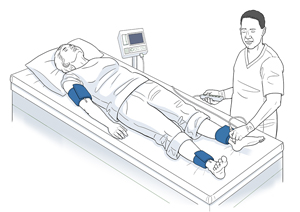Ankle Brachial Index (ABI) Test
The ankle brachial index (ABI) is a simple test that compares the blood pressure measured at your ankle with the blood pressure measured at your arm. It's used to check for peripheral artery disease (PAD) in the legs, or to see if PAD is getting worse. It can also be used to check your risk for heart attack and stroke. A low ABI number may mean that you have PAD.
What is PAD?
A fatty substance called plaque can build up in your arteries. This causes a narrowing or blockage of arteries. PAD often affects the vessels that bring blood to the legs. The reduced blood flow can cause pain and numbness. A low ABI number may mean that your legs and feet aren’t getting as much blood as they need. But an ABI test won’t show exactly which blood vessels have become narrowed or blocked.
Why is this test done?
Your healthcare provider might want you to have an ABI test if you are at risk for PAD. Things that increase your risk for PAD include:
-
Smoking
-
Diabetes
-
Being older than age 70
-
High cholesterol
-
Coronary artery disease
-
Abnormal pulses in your lower legs
-
Being younger than age 50, with diabetes and another risk factor, such as smoking or high blood pressure
The ABI test can:
Your provider also might advise an ABI:
-
If you have symptoms of PAD, such as pain in your legs with activity (not everyone with PAD has symptoms, which makes the test even more important)
-
To see how serious your PAD is—your provider might order this test every year to see if your condition is getting worse
-
To see how well blood is flowing into your legs if you’ve had surgery on the blood vessels of your legs (sometimes providers use ABI to check your risk for heart attack or stroke)
Before your test
There is very little you need to do to get ready for an ABI test:
-
You can eat as normal on the day of the test.
-
You should be able to take any medicines as usual before the procedure.
-
You may want to wear loose, comfortable clothes. This will let the technician easily place the blood pressure cuff on your arm and ankle.
-
You’ll need to rest for at least 15 to 30 minutes before the procedure.
-
Ask if your healthcare provider has any special instructions.
During your test

The ABI test is very similar to a standard blood pressure test. During your ABI test:
-
You will lie flat during the procedure.
-
A technician will place a blood pressure cuff just above your ankle.
-
The technician will put an ultrasound probe over the artery. They will use this to listen to the blood flow through the vessel.
-
The technician will inflate the blood pressure cuff. They will increase the pressure until the blood stops flowing through the vessel. This may be a little uncomfortable. But it won’t hurt.
-
The technician will slowly release the pressure in the cuff. The systolic pressure is the pressure at which the blood flow is heard again. That is the part of the blood pressure measurement needed for the ABI.
-
The technician will repeat this process on your other ankle and on both of your arms.
-
Next, the technician will calculate the ABI. The top number (numerator) is the higher systolic blood pressure found in the ankles. The lower number (denominator) is the higher systolic blood pressure found in the arms.
Sometimes healthcare providers will combine an ABI test with an exercise test. You might have an ABI test done before and right after exercise. This is to see how exercise changes your ABI value.
After your test
-
You should be able to go back to your normal activities right after your ABI test.
-
Follow up with your healthcare provider about your results. In some cases, you may need follow-up testing to get more information about a blocked vessel. This might include an MRI or an arteriogram.
-
Talk with your provider about what your ABI value means for you.
If you have PAD, you may need treatment. Possible treatments include:
-
Stopping smoking
-
Treating high blood pressure, high cholesterol, and diabetes, if needed
-
Staying physically active
-
Eating a healthy diet
-
Taking medicine to increase blood flow to your legs or to prevent blood clots
-
Having procedures to restore blood flow, like angioplasty
-
Having surgery on your leg if the blockage is severe
Possible risks and complications
For most people, there are no risks linked to having an ABI test. But this test is not advised if you have a blood clot in your leg. You may need a different type of test if you have severe pain in your legs.